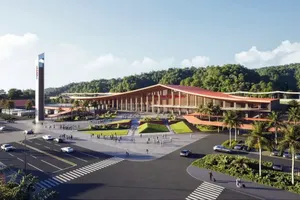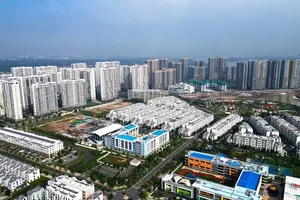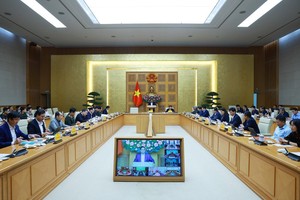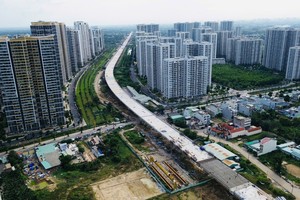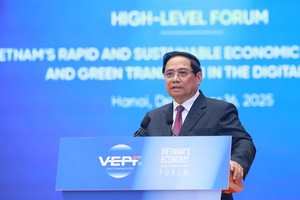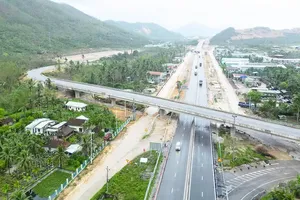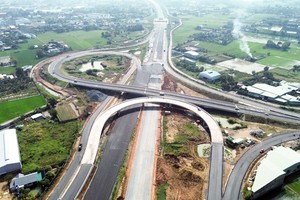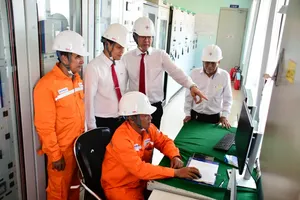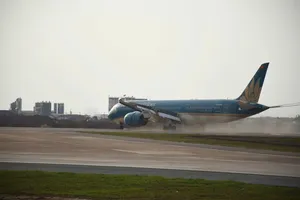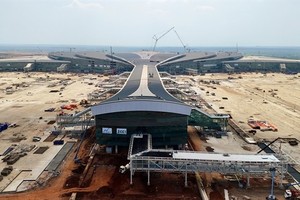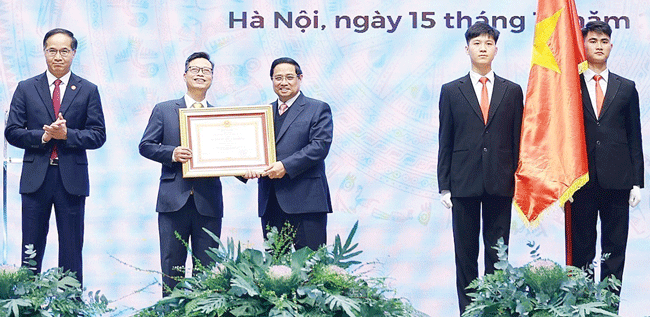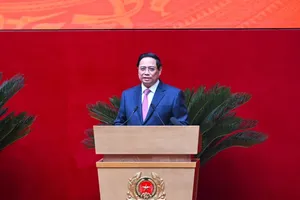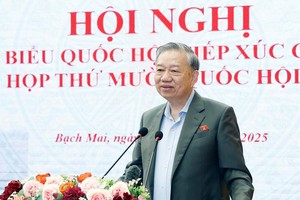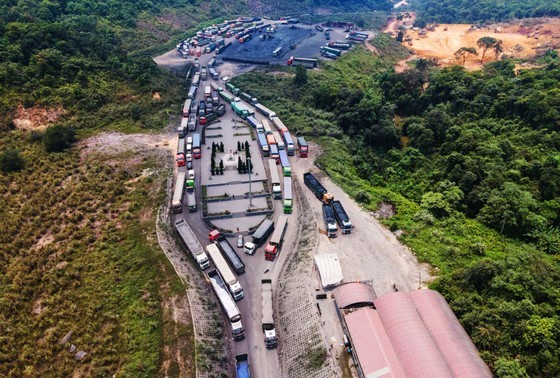 |
Transporting coal from Laos to Vietnam through the La Lay International Border Gate. |
The 1,450-kilometer-long East-West Economic Corridor (EWEC) has connected countries in the Greater Mekong sub-region, including Laos, Thailand, Myanmar, and Vietnam, creating favorable conditions for strengthening economic cooperation, promoting trade, investment, and development. The corridor has also contributed to poverty reduction, supported the development of rural areas and border regions, and facilitated tourism. Nevertheless, the EWEC still requires expansion and scaling up of its East-West axis to fully utilize the development potential of the countries along the route, especially given the strong development of the North-South transport axes.
The creation of the EWEC was intended to accomplish three of the five strategic breakthroughs identified in the Greater Mekong Sub-region Strategic Framework: enhancing connections through multi-sectoral integration, streamlining cross-border trade and investment, and promoting private sector involvement. Despite its potential, this economic corridor has not lived up to expectations over the past time.
Taking a shortcut
The East-West Economic Corridor in Vietnam begins at the Lao Bao International Border Gate in Quang Tri Province, following National Highway 9 and National Highway 1A, before terminating at Tien Sa Port in Da Nang.
Mr. Duong Tien Lam, the representative of the Vietnam Logistics Service Business Association in Da Nang, has stated that there are only two transportation routes regularly used: the Mukdahan (Thailand)-Savannakhet (Laos) segment and the Lao Bao-Dong Ha-Da Nang segment (Vietnam).
In reality, a shipment from Da Nang City to Yangon (Myanmar) takes up to 28 days because goods need to be unloaded and reloaded at each border gate into vehicles of the host country. If container trucks from Vietnam want to avoid this process, they can go through Laos, but it also takes a lot of time to complete the necessary procedures. However, even after that, the containers still need to be transferred to Thai trucks and then again to Myanmar trucks.
Mr. Le Quang Duc, Deputy General Director of Da Nang Port Joint Stock Company, has pointed out that despite its numerous benefits, the amount of goods passing through EWEC is still limited. The high road transport cost, which includes toll stations (contributing 10-15 percent of transportation costs) and fuel expenses, makes it challenging to attract cargo sources from Laos and Northeast Thailand. Additionally, the customs clearance process at the Vietnam-Laos border is sluggish, taking around six hours for a shipment of approximately ten vehicles.
Mr. Nguyen Son Tung, a lecturer at the University of Economics – Da Nang University, highlights that National Road 14B passing through Da Nang serves as a vital East-West axis, connecting Tien Sa port with National Road 1A and the Da Nang-Quang Ngai Expressway. The road has a total length of around 32km, including 24km traversing densely populated urban areas and intersecting with local roads. This creates transportation challenges for businesses and impacts the daily lives of residents. Consequently, many companies opt for "shortcut" routes to save time and reduce costs.
According to Mr. Pha-nom-khon, Head of the Management Board of the Savan-Senvo Special Economic Zone, located in Savannakhet Province, Laos, the economic zone is situated in the heart of the EWEC. Despite this strategic location, businesses in the economic zone prefer to transport goods through Thai ports instead of Da Nang Port. Transportation through Da Nang Port is primarily limited to local and regional markets rather than international ones, mainly due to the high logistics costs. In contrast, transporting goods through Thai ports is more cost-effective and convenient due to streamlined procedures.
Approaching foreign markets through official channels, Ms. Mai Thi Y Nhi, Director of My Phuong Food Co., Ltd., in Hoa Son Commune, Hoa Vang District, Da Nang City, stated that in a seminar one year ago, she expressed her desire to export products to Laos and received quotations from potential partners, including a transport route via Khe Sanh in Quang Tri province, which means passing through the Lao Bao Border Gate. However, when she provided the quotation to her Lao partners, they felt it was too high and requested that the products be sent to Vinh, where they would handle the transportation to Vientiane (Laos) themselves.
Not as expected
Nam Giang Border Gate Economic Zone is linked to the formation of the East-West Economic Corridor 2 (EWEC2), which connects Da Nang and Quang Nam (Vietnam) with Laos and Thailand.
 |
Controlling goods through Lao Bao International Border Gate (Quang Tri Province). |
Compared to Thai border gates, the distance from Northeast Thailand to Da Nang Port is only about 600km, 300 kilometers closer than transporting to Laem Chabang Port (near Bangkok). When it comes to importing and exporting goods through sea routes to North Asian countries via Central Vietnam seaports such as Da Nang Port and Ky Ha Port (Chu Lai), the distance is 1,200 nautical miles closer than the distance through Bangkok Port.
Compared to Bo Y Border Gate in Kon Tum Province and Lao Bao Border Gate in Quang Tri Province, Nam Giang Border Gate remains competitive in attracting goods. If the 123km road to La Mam in Sekong Province, Laos is made accessible, goods traveling from Bangkok to Da Nang only need to traverse around 300km. Moreover, trade via EWEC2 from Bangkok to Da Nang will cover only about 1,100km, almost 400km shorter than transportation through the Lao Bao Border Gate.
Despite the advantages of being on EWEC2, commercial activities between localities in the central region, especially Quang Nam and Da Nang City, and localities in Thailand or Laos have not met the expected levels recently.
Nguyen Thanh Tam, a truck driver who frequently travels on this route, said the transport route could be linked through the national highway system 514B, 14E, 14D, 14G, and 40B. However, many of these routes are too narrow and have poor road surfaces, which pose significant challenges for the transportation and preservation of goods.
"Compared to the routes for transporting goods to Tien Sa Port from Da Nang City for exports, we choose this route due to its shorter distance. However, the steep incline of the pass limits the speed of the vehicles," Tam explained.
For several years, on average, the Central PetroVietnam Investment and Production Joint Stock Company in Dien Nam - Dien Ngoc Industrial Park has imported approximately 30 percent of liquefied natural gas materials from Thailand. However, the products they manufacture are primarily consumed domestically, with a small portion being exported to Laos, and there is almost no presence of their products in the Thai market.
According to Mr. Le Van Tan, Deputy Director of Dong Phuong Co., Ltd., located in Dien Nam - Dien Ngoc Industrial Park, there is a high volume of Thai goods entering the Vietnamese market, but domestic enterprises face challenging technical barriers when exporting their products to Thailand. As a result, the company primarily distributes its goods in Thailand through a Japanese trading company.
The routes of EWEC have been established and are clear, and numerous new highways have been invested in and put into operation, including the Cam Lo - La Son - Tuy Loan Expressway. Nevertheless, many national roads are still too narrow and have poor road conditions. Moreover, they pass through residential areas, which causes obstructions to the transportation of goods. Meanwhile, investing in the construction and expansion of national roads still encounters numerous challenges and requires finding solutions.

